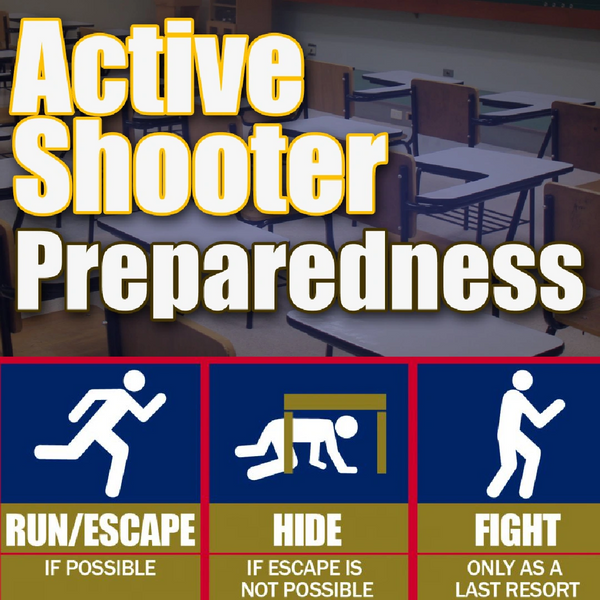Why Active Shooter Training Is Crucial for Workplace Safety And Security
Why Active Shooter Training Is Crucial for Workplace Safety And Security
Blog Article
Carrying Out Energetic Shooter Training: Finest Practices for Developing a Safe and Prepared Neighborhood Atmosphere
As communities challenge the distressing truth of active shooter occurrences, the application of thorough training programs comes to be imperative. What are the critical elements that can transform a conventional training program into a durable version for community durability?

Recognizing the Demand for Training
In an age marked by increasing incidents of violence in public rooms, recognizing the demand for active shooter training has never ever been much more essential. Comprehensive training efforts can furnish individuals with the knowledge and skills to react emphatically.
In addition, the psychological impact of physical violence on individuals and neighborhoods can not be overstated. Training cultivates a sense of empowerment and readiness, allowing people to really feel more safe and secure in their environments. It additionally promotes a culture of safety, where awareness and watchfulness end up being integral components of everyday life. The advantages of energetic shooter training expand past instant reaction; they consist of improving communication protocols and improving general precaution within organizations.
Key Components of Effective Programs
Reliable energetic shooter training programs incorporate numerous crucial components that enhance readiness and response capabilities. Initially, thorough curriculum growth is essential, ensuring that training content is pertinent, evidence-based, and customized to the specific requirements of the company or community. This consists of understanding the dynamics of energetic shooter cases and the mental effect on people involved.
2nd, sensible training scenarios need to be used to imitate potential scenarios, permitting individuals to practice decision-making and response techniques in a regulated atmosphere. These drills promote muscle mass memory and develop confidence amongst individuals.
Third, an emphasis on interaction protocols is essential. Developing clear lines of communication amongst police, emergency responders, and participants makes certain collaborated actions during an occurrence. Regular updates and correspondence course help keep interaction paths clear and efficient.
Fourth, continuous examination and feedback systems must be incorporated into the training program - active shooter training. Evaluating the effectiveness of training through individual comments and performance metrics permits continual renovation
Lastly, promoting a culture of security and readiness within the community urges vigilance and positive procedures, ensuring that people are not just experienced however likewise taken part in preserving a safe setting.
Engaging Neighborhood Stakeholders

To effectively involve these stakeholders, it is vital to interact the objectives and benefits of the training. Hosting informational sessions can assist clarify the training's purpose, address concerns, and detail the roles each stakeholder may play. Creating a stakeholder advisory committee can assist in ongoing discussion, allowing for diverse viewpoints and understandings to be integrated into the training program.
Structure connections with area leaders and organizations is also crucial. Their support can improve outreach efforts, increase engagement, and make certain that training is customized to the unique needs of the community. Furthermore, stakeholders can help in sharing details and sources, strengthening the message of safety and preparedness.
Eventually, involving neighborhood stakeholders not just reinforces the training initiative yet likewise cultivates a feeling of possession amongst residents, bring about a more resistant and educated community with the ability of responding successfully to potential threats.
Educating Shipment Techniques
Using a range of training distribution approaches is important to suit the varied discovering styles and requirements of individuals in active shooter training programs (active shooter training). Efficient training can take a number of kinds, including talks, hands-on simulations, online components, and interactive workshops. Each technique serves a special objective and can improve the general discovering experience

Online components use flexibility and accessibility, making it possible for individuals to discover see at their very own pace. These can consist of videos, quizzes, and discussions to gauge understanding. Interactive workshops urge seminar and problem-solving, promoting team effort and interaction skills.
Including a mixed strategy that incorporates these methods not only enhances the training experience but additionally makes sure that individuals are better prepared to react successfully in case of an active shooter scenario (active shooter training). By attending to numerous learning preferences, organizations can create a much more informed and receptive neighborhood
Constant Evaluation and Renovation
Normal assessment and improvement of active shooter training programs are vital to preserving their relevance and effectiveness. As risks progress, so should the techniques and approaches employed in training. Continuous analysis ensures that training content shows the current knowledge on active shooter incidents, including lessons gained from current occasions and readjusting for arising patterns.
To promote this process, check this companies should establish responses mechanisms that include individual assessments, expert testimonials, and incident debriefs. Collecting information on participant efficiency throughout drills and exercises is essential, as it highlights locations needing enhancement and informs future training sessions. In addition, engaging with police and emergency -responders can give beneficial understandings right into the functionality and applicability of training protocols.
Regularly set up reviews of training materials and strategies should be mandated, cultivating an environment of technology and versatility. Organizations should additionally encourage a society of recurring learning, where employee feel equipped to suggest modifications based upon their experiences. By committing to constant assessment and improvement, companies not only boost the performance of their energetic shooter training programs yet additionally strengthen their general commitment to safety and readiness within the community.
Verdict
Finally, reliable implementation of active shooter training demands a detailed strategy that prioritizes area involvement and practical simulations. By developing customized educational programs, integrating diverse training techniques, and cultivating collaboration amongst stakeholders, communities can improve preparedness. Continuous assessment original site and feedback mechanisms are important for adapting programs to emerging hazards, thereby reinforcing general safety. Ultimately, a dedication to continuous training and improvement cultivates a culture of watchfulness and readiness, making sure a more secure atmosphere for all neighborhood participants.
Report this page